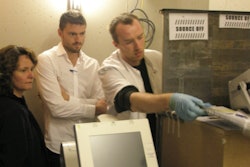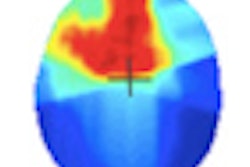
Everyone agrees that patients undergoing radiotherapy usually do not resemble uniform water spheres with a 30-cm diameter. Nevertheless, this is the common assumption of radiation dose calculations used for brachytherapy.
Real patients, of course, are complex in shape, as are the tumors being targeted for irradiation. Real patients also don't consist of uniform water, but comprise a mix of many tissues, such as muscle, fat, glands, organs, bone, and lung. Moreover, foreign bodies may be present, such as metal applicators, prostheses, shielding, and radiation sources. All of these can influence dose calculations but are currently not taken into account in brachytherapy.
As evidence grows of the non-negligible effects of a patient's shape and composition, an American Association of Physicists in Medicine (AAPM) initiated task group has examined these complexities with the aim of improving the accuracy of brachytherapy dose calculations.
Brachytherapy primer
Of all cancer patients receiving radiotherapy as part of their disease management, about 10% are currently treated with brachytherapy. The technique involves temporarily or permanently implanting small radiation sources in, or close to, a tumor. This way, radiation dose is tightly conformed to the tumor, while the surrounding healthy tissue is spared as much as possible.
Brachytherapy sources usually consist of radioactive isotopes, but more exotic forms also exist, such as electronic brachytherapy sources -- miniature implantable x-ray sources that can be turned on and off. There are two categories of sources when it comes to the emitted photon energy. High-energy sources (such as Ir-192) emit photons with energies well above 50 kiloelectron volt (keV), while low-energy sources (such as I-125, Pd-103 or electronic brachytherapy sources) produce photons with energies below 50 keV.
Because the sources are placed close to the tumor, the technique is immune to the motion problems encountered in external beam photon therapy, since the sources move with the tumor. There are, however, clear disadvantages to brachytherapy, which account for its lesser popularity. For starters, it's an invasive, labor-intensive procedure that requires handling of radioactive materials, with the associated safety issues. In addition, many tumors are considered too large to be treated with brachytherapy. These issues explain why the majority of radiotherapy patients are treated with external radiation beams.
TG-43 and beyond
As mentioned above, brachytherapy patients are considered to be water spheres for dose calculations. This was the approach advocated by the Task Group 43 report (TG-43) of the AAPM in 1995. TG-43 has been highly successful in providing a standard dose calculation technique for brachytherapy and improved accuracy by taking into account interior source geometry and by assuring brachytherapy source strength traceability to established standards.
Essentially, TG-43 allows dose to be calculated at any distance from any small radiation source, by factoring the dose as a simple product of a few functions that are quite intuitive. One of the functions, the radial dose function, for example, describes how the dose falls off with distance from the source along a direction perpendicular to the source axis.
All functions depend only upon the source's geometry and composition. Data in the form of lookup tables are available for all sources commonly used in brachytherapy. The approach is simple, but its true strength lies in the standardization that it enabled: the whole world calculates dose to brachytherapy patients in the same traceable way, which facilitates comparison. However, because everyone is using a water sphere as the patient model, the whole world may also be calculating the same thing and getting it wrong.
There is a growing body of literature demonstrating the non-negligible effects of the shape of the patient and the presence of materials other than water. These issues were the subject of three years of intense scrutiny by another AAPM Task Group and resulted in the recent release of the "Report of the Task Group 186 on model-based dose calculation methods in brachytherapy beyond the TG-43 formalism: Current status and recommendations for clinical implementation". The report has received wide international endorsements from AAPM, American Brachytherapy Society (ABS), the Australasian Brachytherapy Group (ABG), and the European Society for Radiotherapy and Oncology (ESTRO).
This important 29-page report is just the first step toward taking the complexities of real patient/source/applicator geometries into account, in order to improve the accuracy of dose calculations in brachytherapy. The report addresses issues including: the differences in fundamental physical interactions of photons in materials other than water; tissue information extraction from various medical imaging modalities; the difference in behavior of low- and high-energy brachytherapy sources; new dose calculation algorithms that can take patient heterogeneities into account; and clinical commissioning of these algorithms.
The first issue is the influence of materials in the patient, other than water (in fact, a patient contains very little pure water). Figure 1 clearly shows that the mass energy absorption coefficient, an important physical quantity directly related to dose calculations, differs drastically in human tissues compared with water, for photons with energy below 200 keV. The differences can amount to more than a factor of ten in some media. It's therefore clear that considering patients as solely constituting water can result in grave dose errors, mostly affecting low-energy photon sources.
Oddly, these issues also exist in external beam photon radiotherapy, yet despite the dose differences between water and actual media being limited to a few percent for high-energy photons, the community adopted heterogeneous dose calculations a long time ago.
Images and algorithms
If we all agree that taking real tissues into account is a good idea, this immediately raises another issue: How are we going to obtain the necessary information? One fact unearthed by the AAPM task group is the surprising lack of knowledge regarding the composition of human tissues in general, let alone the details for a particular patient. The report also discusses at length the limitations of various imaging modalities to enable accurate tissue definition, concluding that much more research may be needed into novel imaging approaches, such as dual-energy CT, for example.
Realizing that we want to advance beyond the simple TG-43 dose calculation method, many physicists will immediately think of Monte Carlo simulations as a supreme tool for dose calculations of unparalleled accuracy. Unfortunately, Monte Carlo simulations can produce vastly different results to TG-43 water sphere calculations.
There are also other dose calculation methods available or under development, such as grid-based Boltzmann solver (GBBS) and the collapsed-cone convolution method (CCC), the latter being an approach that's well known in external beam radiotherapy. Right now, the only commercially available brachytherapy treatment planning system that can handle complex geometries for dose calculation is Acuros BrachyVision (Varian Medical Systems), which is a GBBS based on finite element methods. This offers a deterministic dose calculation method, as compared with the stochastic methods used by Monte Carlo simulations. The latter are currently only employed in various groups for research purposes, though vendor-supported solutions may soon be available.
One final important issue is that when photon transport is performed in materials other than water, one has the choice to specify the dose as dose-to-medium, or opt to only transport photons in the correct media and then score the dose in water. This is a subtle point that's not easy to grasp immediately, but it has potentially significant consequences in how brachytherapy dose is prescribed clinically and how it correlates with outcome.
All this and more, including concerns about standardization, is discussed in the TG-186 report. It is one of those reports that, while providing guidance to early adopters, also raises more questions. It is hoped that it may serve to initiate many studies that will provide the missing pieces of the puzzle.
Frank Verhaegen, PhD, is a professor and head of clinical physics research, at Maastro Clinic, Maastricht, the Netherlands.
Luc Beaulieu, PhD, is a professor and head of radiotherapy physics research at the Centre Hospitalier Universitaire de Québec, Canada.
© IOP Publishing Limited. Republished with permission from medicalphysicsweb, a community website covering fundamental research and emerging technologies in medical imaging and radiation therapy.




















